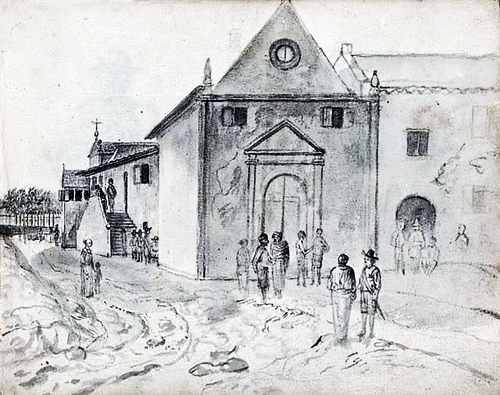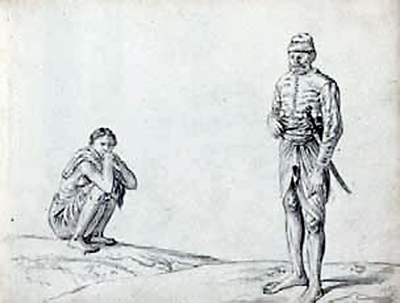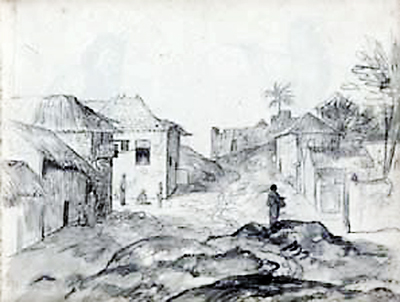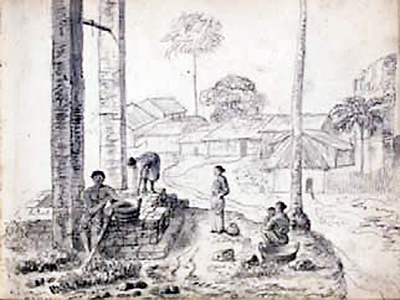Colombo in 1662: Through the eyes of artist Esaias Boursse

Former Franciscan Monastery inside the city
1662 in Colombo was a strange time. The fortified Portuguese city had fallen to the Dutch East India Company (VOC) only six years earlier and was in a period of transition, spatially and aesthetically. The long siege of the city in 1655/1656 had left the eastern fortifications in ruin together with much of the buildings on that side. The Dutch initially planned on refortifying the broken ramparts of the Portuguese but abandoned that plan altogether and redesigned Colombo from scratch.
By the end of the 1670s, Dutch Colombo was vastly different from Portuguese Colombo; they had completely redeveloped the urban layout, demolished old buildings and built new ones and also new fortifications. These large scale demolitions and remodelling took place from the late 1650s till about the 1670s. So in 1662 Colombo was in transition, with much of the Portuguese buildings still around.
The description of Colombo in 1661 by Wouter Schouten captures this perfectly:
“Whilst thus riding at anchor off Columbo, we found an opportunity to go and see this old and famous town. Many fine buildings, even whole streets, were lying in ruins, partly from age, partly from sieges and wars, and many of the ruins were covered with grass and brushwood. Nevertheless, we found in the town fine buildings, lofty churches, wide streets and walks, and large houses in great number. They were built spacious, airy, and high, with stone walls, as if meant to stand for ever, according to the Portuguese manner of building.”

Sinhalese soldier and labourer
A pictorial glimpse of this period comes to us through the eyes of the Dutch artist Esaias Boursse.
An employee of the VOC, Boursse made over a hundred sketches of daily life in Colombo, mainly focused on people and the work they were engaged in. This collection called the “Tijkenboeck” is held by the Rijksmuseum in Amsterdam. This album containing 116 sheets of drawings came into the possession of the Rijksmuseum in 1996. Its value outweighs the poor quality of some of the drawings in that it captures scenes from within a citywhich was being transformed from its Portuguese outlook to the Dutch; some scenes depict street views of Portuguese Colombo-a phenomena never before captured in drawing except for textual descriptions.
An introduction to this unique pictorial source was written by Lodewijk Wagenaar and Mieke Beumer under the title “Esaias Boursse’s ‘Tijkenboeck’: A Pictorial Catalogue of People Working and Living in and around Colombo, 1662”and published in The Rijksmuseum Bulletin, Vol. 67, No. 4 (2019), pp.312-331.

Street view in Colombo
Esaias Boursse (1631-1672) was born in Amsterdam and trained as a painter, but unable to find work, he enlisted in the VOC as a midshipman in 1661 and sailed for Batavia (Jakarta) in October that year. Arriving in Batavia in March 1662, he was soon transferred to Colombo where he served for a few months, though it is not known in what capacity. He left Colombo in December 1662 for the Netherlands. He died at sea in December 1672 on his way to Ceylon after having once again joined the VOC.
The real significance of his drawings, is that they are the only known street-view depictions of Portuguese Colombo. There are several textual descriptions of the city and few vague maps of the city even depict buildings. However these are more artist impressions and hence Boursse’s drawings are the only known views of what Portuguese Colombo really looked from within.
The most interesting drawing is the depiction of the Franciscan monastery which was at the present Gordon Gardens in Fort. It is a first-time look at the church architecture of Colombo during the Portuguese period. This monastery is frequently mentioned in textual sources and depicted on vague maps.It was one of the few buildings to survive the initial Dutch demolition and was used by them for some time.

People near a well - wall to the right looks part of a ruined building
An interesting anecdote of this monastery is that it was in this church that King Dharmapala of Kotte was buried in 1597, and we finally see what it looked like.
Many of the other drawings also capture scenes of buildings and houses but their precise location is hard to determine (whether within or outside the city). The main focus of the artist was clearly the people whom he captures in minute detail especially their dress. The various ethnicities too could be identified from the drawings. Almost all the people depicted are engaged in manual labour possibly associated with removing earth and the authors of the paper hypothesize that they must be all engaged with the large construction work associated with the demolition and remodelling of the fortifications during this period.



